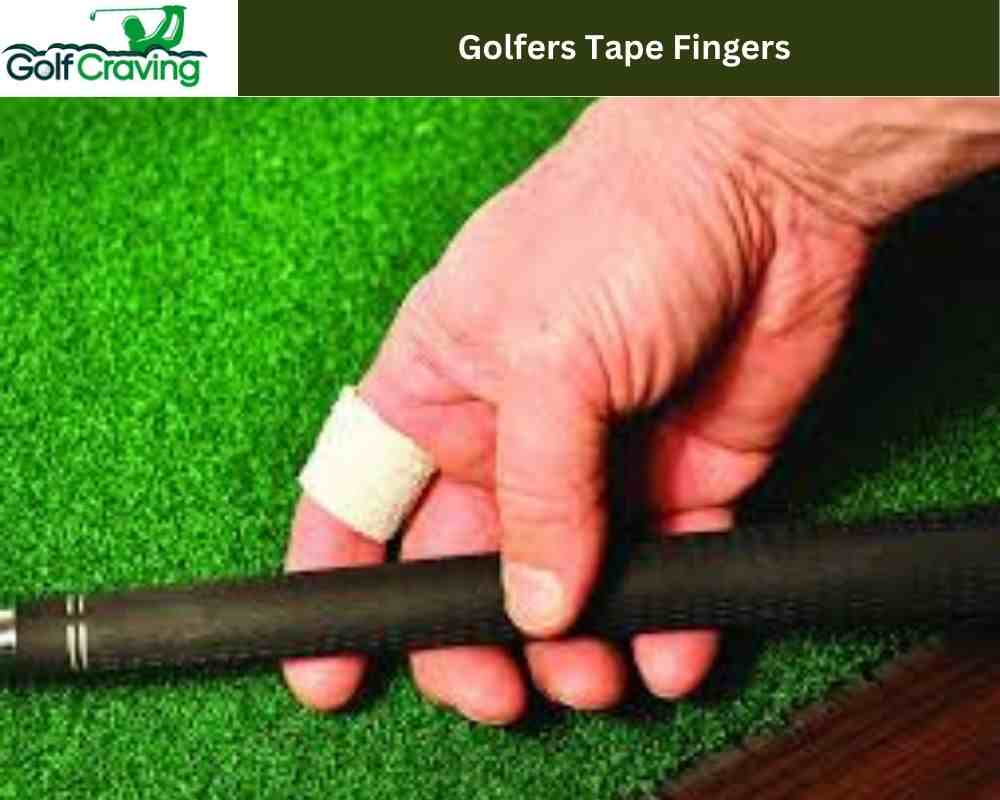Although it may seems like a relaxing activity, golf puts a lot of physical strain on the body. The repetitive motion of holding and releasing the club may be taxing, especially on the hands.
Therefore, golfers frequently have blisters and calluses as a result of these movements. So, why do golfers tape their fingers? Many people find that athletic tape helps alleviate the pain of blisters and calluses.
Players like Justin Leonard and Justin Thomas, often have their fingers taped. So, willing to know more? Let’s dive in!
Why Do Golfers Tape Their Fingers – Main Reasons

The hands play a crucial role in the complex golf swing dance. The power and accuracy with which a golfer grips the club determines the ball’s trajectory and distance. Therefore, performance on the green is threatened by any injury to this vital appendage.
Careful hand hygiene is an absolute must for professionals like Tiger Woods. After years of constant practice, Woods’ split calluses have become so painful that he needs the unwavering support of medical tape to keep him focused on his game.
Not only him, but other golfers also choose to use tapes for their hands. Here are the reasons behind it:
Blisters
Golfers often have blisters, especially on the hands, because they are the main contact point between the player and the club. Blisters are more than just an annoyance for professional golfers; they may be a major detriment to their performance and financial stability.
If they experience any pain or injury in their hands, it might affect their performance and perhaps cause them to withdraw from the tournament. Even with a supple leather glove covering it, the left hand might still develop blisters and calluses.
Taping their hands can prevent them from developing blisters and the additional issues that it causes. Therefore, they can play peacefully without worrying about the pain. Also, it enhances their performance to some extent.
Calluses
The development of calluses is a typical reaction of the human body to the constant rubbing and pressure that golfers experience on their skin. Similar to blisters, calluses generally manifest on the hands, especially in the regions where the club grip is the most forceful.
The development of Calluses protect the skin against tearing and bleeding, albeit they are a bit of a pain in the neck. However, calluses can grow unpleasant and hinder a golfer’s performance if they are not addressed.
In addition to being painful, skin splitting hinders the hand’s capacity to make the exact motions needed for a good swing.
Calluses take a long time to heal. But with the usage of finger tapes, golfers can prevent the occurrence of them. As a result, their fingers remain protected and they can focus better on the course.
How To Tape Your Fingers While Golfing?
Taping your fingers works great to prevent blisters and calluses while golfing. Finding the proper tape and wrapping it around your fingers appropriately are the two most important factors.
The first step in taping a single finger is to wrap the tape around the affected region. Be careful not to wrap the tape too tightly, since this might cut off blood flow.
After you’ve wrapped the tape around your finger all the way, trim off the excess with scissors.
The procedure is the same for taping two fingers together, except for extra rigidity, you should double-wrap both fingers. It must be said, nevertheless, that double tapping is a highly debated topic in certain sports, such as golf.
Even though it can enhance your grip and swing, it could be seen as dishonesty if done without a real injury.
Things To Consider
- Type Of Tape
It is critical to choose the appropriate tape for the activity, like golfing, when taping fingers. Golfing tape needs to be sticky, less stretchy, and wider.
In sports like golfing, where grip and finger strength are vital, using the right tape ensures that it gives the support and stability that is essential.
- Skin Protection
For further skin protection, tape your fingers together before engaging in golfing. At the end of lengthy, strenuous golfing sessions, when fingers are raw and susceptible, the tape helps avoid skin rips and injuries by establishing a layer of protection.
Nevertheless, there are downsides to utilizing tape as a skin protector. In addition to lowering friction, it can lessen sensitivity and grip on grips.
The Benefits Of Using Finger Tape In Golf

Once you start using tapes while golfing, you will certainly get some advantages . Here are some benefits of the finger tapes:
- Improve Your Grip
One of the primary benefits of using finger tape in golf is the significant improvement in grip it provides. With grip tape applied, players can have confidence that their grip will remain secure, even during intense rallies or crucial moments in a match.
This assurance allows players to focus on their shots without worrying about their grip slipping, ultimately leading to better performance on the court.
- More Consistency
Another advantage of using finger tape is the increased consistency it offers during play. When players no longer need to concern themselves with their grip affecting their shots, they can play with greater confidence and concentration.
This enhanced focus enables players to execute their strokes more consistently, leading to improved overall performance and fewer errors during matches.
- Protects Your Fingers
In addition to enhancing grip and consistency, finger tape provides valuable protection for players’ fingers. Golf can be physically demanding, especially during long training sessions or extended matches.
Continuous gripping of the wedges can lead to soreness and discomfort in the fingers. However, by wearing tape, players can reduce friction and pressure on their fingers, allowing them to train and compete for longer periods comfortably.
- Faster Swing
Using grip tape also facilitates a faster swing, leading to increased power and effectiveness. With the assurance of a secure grip, players can swing more aggressively, generating greater speed.
Overall, finger tape contributes to a more dynamic and potent playing style, enhancing a player’s ability to dominate matches.
3 Alternative Ways To Prevent Blisters And Calluses
You can rely on other methods to prevent blisters and calluses as well. Here are some proven ways to follow:
Keep Your Hands Dry
Maintaining dry hands and grips is a fundamental strategy for preventing blisters while playing golf. Wet conditions, whether from rain or sweat, can increase friction between the hands and the club, leading to blisters and calluses.
Regularly wiping your hands and golf grip during play can help reduce moisture buildup and minimize the risk of blisters. Additionally, using products like powder or rosin can aid in keeping hands dry and enhancing grip stability.
Re-grip Your Clubs
Worn-out grips on golf clubs can contribute to blister formation due to increased friction between the hands and the deteriorating surface. Periodically inspecting and replacing worn grips can alleviate this issue and promote a smoother, more comfortable grip.
Golfers can either re-grip their clubs themselves if confident or seek professional assistance from a golf shop for a thorough re-gripping job. Fresh grips ensure optimal performance and reduce the likelihood of developing blisters during play.
Adjust Your Grip
In some cases, the way a golfer grips the club can lead to blister formation on the fingers and hands. Experimenting with different grip styles and positions can help identify which techniques contribute to blistering and which do not.
Professional Golfers can utilize a trial-and-error approach during practice sessions to find a grip that minimizes friction and discomfort. Consistent practice with the adjusted grip is essential to maintaining proper form and preventing blisters over time.
Frequently Asked Questions (FAQs)
Why did Tiger Woods tape his finger?
As is typical practice for PGA and amateur golfers and baseball players, Tiger Woods uses finger tape to avoid blisters and keep a firm hold on the club. It may be necessary to retire from competition if blisters cause discomfort.
Does taping fingers prevent injury?
While typical taping techniques may not always provide the best results, taping the fingers can help protect the tendons from harm.
With the right use of tape techniques, you may provide your fingers more support and lessen the likelihood of tendon injuries.
Why do golfers put tape on their middle finger?
Tape is a common remedy for golfers who suffer from blisters, calluses, cuts, hot spots, or any other discomfort that may arise from grasping the club. This is especially true for the middle finger.
Which finger does Tiger tape?
Tiger Woods secures a firm grasp on the golf shaft by wrapping his right middle finger with glue. For further protection from blisters and other skin irritations, many golfers wear bandages on their left hands, usually on fingers that brush against the grip.
Conclusion
Now you know why do golfers tape their fingers. This is a common practice as blisters and calluses are commonly seen in golfers’ hands due to extensive practice. Therefore, if you are struggling with the same issue, try using a finger tape to change the game!
